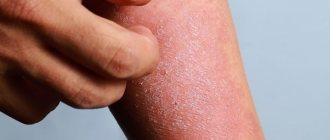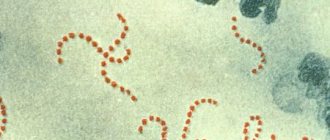Dermatitis is the general name for a group of inflammatory skin diseases that have different origins. The disease can affect any part of the body, but most often appears on the skin of the hands, feet and face. The main symptoms are itching, burning, and damage to the skin, which causes a lot of inconvenience and significantly impairs the quality of life. Most often, these manifestations are short-lived, but sometimes the pathology becomes chronic. In any case, dermatitis needs to be treated with medications, including ointments and creams, recommended by a doctor.
Types of dermatitis and diagnosis
Depending on the causes of manifestation and the nature of the course, the following types of dermatitis are distinguished:
- simple contact;
- allergic;
- allergic contact;
- seborrheic;
- atopic.[1]
Diagnosis of dermatitis is based on examination of the patient and laboratory tests, including a general blood and urine test, a biochemical blood test, an immunological blood test to determine the level of Ig E, which makes it possible to determine the allergic nature of the disease, and allergy skin tests. Based on the research results, the doctor will be able to assess the picture of the disease and select an effective treatment regimen. In some cases, allergists, infectious disease specialists, and immunologists are invited for consultation.[2]
Causes of the disease
There is no single cause for the development of atopic dermatitis. The occurrence of the disease is facilitated by a whole complex of conditions: genetic characteristics and environmental factors. These include a violation of the protective function of the skin (it becomes more vulnerable to the effects of detergents or other irritating factors), characteristics of the immune system, climatic conditions (temperature, humidity, dust, tobacco smoke and other impurities in the external environment). Possible effects of the microbiome are being studied.
Treatment of dermatitis
Treatment of dermatitis is a whole range of measures, including therapeutic and physiotherapeutic procedures with the prescription of general and local medications (creams, ointments). The main goal of therapy is to eliminate disturbing symptoms (itching, burning, rashes) and prevent secondary infections. Overall success in treatment is possible only with strict adherence to medical recommendations.
Dermatitis must be treated individually in each specific case. Sometimes it is enough to eliminate contact with the irritant. In difficult cases, drug therapy is selected with the prescription of local agents and antihistamines.[3]
How does the immune system normally work?
The concept of atopic dermatitis reflects the immunological mechanism of pathology development. It is based on the body’s ability to produce an excess amount of antibodies in response to incoming allergens. Antibodies combine with the allergen, which provokes a more pronounced allergic reaction than should be normal.
Let's figure out how the immune system should work normally. It’s worth starting with the fact that the system is represented by several organs (thymus, lymph nodes) and immunocompetent cells. Their main task is to protect the body from foreign elements: viruses, bacteria, fungi and allergens. This is accomplished through the development of protective reactions that are provided by certain cells. That is, the immune system recognizes foreign elements, destroys them and forms immunological memory.
Two types of cells help to perform such functions - B-lymphocytes and T-lymphocytes (killers, suppressors and helpers). Each type of cell has its own role in the operation of the system. Thus, B lymphocytes recognize foreign elements and form memory cells. T-killers are necessary to destroy foreign elements, T-helpers are involved in strengthening the immune response in response to the penetration of pathogenic agents. Suppressor T cells regulate the strength of the immune response by controlling the number of helper and killer cells.
The key to proper functioning of the immune system is a certain ratio of immunocompetent cells. With any quantitative disturbances, the immune reaction becomes pronounced, which is what happens during atopic dermatitis.
To prevent repeated exposure to the pathogen, the immune system forms a memory. It is synthesized by certain antibodies, or immunoglobulins, that form on the surface of B lymphocytes. Antibodies are proteins that have high specificity for antigens. As a result of their connection with antigens, an immune response is triggered in the body.
Several types of antibodies may be present in the body - immunoglobulins A, M, G and E. Each of them has its own function. For example, immunoglobulins A are responsible for protecting the respiratory tract. Immunoglobulins M and G are components of humoral immunity and arise as a result of the penetration of bacteria and viruses. Also, immunoglobulins G appear some time after the disease and can remain in the body for up to several years.
Immunoglobulins E arise as a response to the penetration of allergens. They are the ones who trigger an allergic reaction, which is accompanied by the release of various biological substances (for example, histamine). Under the influence of these substances, a person develops characteristic allergy symptoms: redness, itching, swelling.
Normally, the body contains very little immunoglobulin E, since these cells quickly disintegrate. However, as a result of a genetic mutation, some people have very high levels of these immunoglobulins, which increases the risk of developing atopic dermatitis on the face and body.
When it first encounters a foreign element, the immune system synthesizes certain antibodies. They help protect the body from re-infection for a certain period of time. During an allergic reaction, the process occurs differently. Upon contact with an allergen, a sufficient amount of antibodies is produced, which will subsequently bind to the allergen. Upon repeated contact, an antigen-antibody complex appears. An allergen acts as an antigen. An antibody is a protein produced by the body.
The antigen-antibody complex triggers a whole chain of immunoallergic reactions. With a large amount of immunoglobulin E, a pronounced and prolonged allergy appears. Simultaneously with the allergic reaction, a number of biologically active substances are released. It is these substances that trigger pathological processes that lead to the appearance of typical allergy symptoms. If the amount of immunoglobulins remains high, then the allergic reaction does not disappear, which indicates the development of atopy.
Ointments and creams for dermatitis
Creams or ointments for dermatitis have slightly different compositions. Thus, the ointment is made on a fat basis, which can be used as vegetable or mineral oils or animal fats. Such products have a dense, slightly viscous structure. They are not immediately absorbed into the skin, but penetrate into its deeper layers. Ointments are not recommended for treating wet surfaces. They are much more effective against dry rashes and chronic inflammation.
Creams have a different base - hydrophilic. Thanks to this, they have a lighter structure, are well absorbed and do not leave greasy marks on the skin. The creams are suitable for the treatment of moderately weeping rashes; they are used for acute inflammation, for lesions of the facial skin and areas with a large number of sebaceous glands, where the use of oily products is undesirable.
Let's consider several options for dermatitis remedies used in medical practice:
- hormonal ointments with pronounced antiallergic and anti-inflammatory effects, which include topical corticosteroids;
- non-hormonal topical agents that have anti-inflammatory and antibacterial effects, relieve itching and promote wound healing.
Non-hormonal drugs
Non-hormonal creams do not contain corticosteroids. The composition may be based primarily on plant components, or not contain them at all. These medications do not act quickly. Their main advantage is the possibility of using them for a long time, including in children. Among non-hormonal creams and ointments there are products with antiseptic, anti-inflammatory, moisturizing, and regenerating effects.
Hormonal drugs
Hormonal ointments and creams in the treatment of dermatitis are considered more effective than non-hormonal ones. The drugs can contain either one active component (topical glucocorticosteroid) or have a complex effect due to the presence of an antibiotic and an antifungal agent in the composition. The use of combined drugs is advisable in case of a complicated course of the disease, when a secondary bacterial or fungal infection is added to the inflammation.
Treatment of atopic dermatitis
To achieve maximum effectiveness from therapy, it is recommended to follow an integrated approach:
- identify and, if possible, eliminate the factors causing atopic dermatitis;
- drug therapy with local agents, selected depending on the severity and form of inflammation;
- proper skin care using moisturizers and softening agents (emollients).[4]
Akriderm preparations are products for the local treatment of manifestations of atopic dermatitis with a wide spectrum of action, produced in the form of cream and ointment of 15 g and 30 g. Depending on the severity, localization, form and course of the disease, the drug is selected:
- with one active ingredient – Akriderm® ointment and cream;
- combined preparations “hormone + antibiotic” - ointments and creams Akriderm GENTA;
- combined preparations “hormone + antibiotic + antimicrobial component” - ointments and creams Akriderm GK.
The modern drug Akriderm GK is a potent drug[5] and has 4 effects at once:
- anti-inflammatory;
- antiallergic;
- antibacterial;
- antifungal. [6]
Treatment of seborrheic dermatitis
The cause of seborrheic dermatitis is infection of the skin by the yeast-like fungus Malassezia. For its treatment, external antimycotics or antifungal drugs are prescribed. Akriderm SK ointment contains betamethasone and salicylic acid. The drug has anti-inflammatory, anti-allergic, anti-exudative, anti-edematous and antipruritic effects, inhibits the accumulation of leukocytes, inhibits phagocytosis, reduces vascular tissue permeability, and prevents the formation of inflammatory edema. As a result of use, the microflora of the skin is restored, scales are exfoliated and sebum production is normalized.[7]
Treatment of allergic dermatitis
To successfully treat allergic dermatitis, it is first necessary to determine the allergen that provoked the disease and partially or even completely eliminate the provoking substance. In the acute period, a specialist may prescribe the use of compresses with cold water and tanning decoctions, which are applied every 3-4 hours for 15 minutes. This helps reduce skin weeping. Drug treatment involves the use of topical glucocorticosteroids in the form of ointments and creams, which are selected depending on the form and severity of inflammation.[8]
If allergic dermatitis is complicated by a microbial infection, it is recommended to use combined external medications, such as Akriderm GK, which, in addition to GCS, contain an antibiotic (gentamicin) and an antifungal component (clotrimazole).
Remember that treatment of dermatitis and selection of medications is carried out only by a specialist dermatologist after a preliminary consultation and examination of the patient.
Etiology and pathogenesis
The main role in the pathogenesis of atopic dermatitis is played by hereditary determinism, that is, heredity. It is a number of hereditary mutations in genes that lead to disruption of the skin barrier and defects of the immune system. The patient also has hypersensitivity to allergens, an increased number of inflammatory mediators and a number of pathogenic microorganisms such as Staphylococcus aureus and Malassezia furfur.
The pathological reaction of the body, which provokes atopic dermatitis, occurs as a result of the interaction of three factors:
- skin barrier dysfunction;
- disturbances in the functioning of the immune system;
- influence of environmental factors.
In addition to the factors described, skin barrier dysfunction can be affected by:
- Reduced levels of ceramides (lipids), which protect the skin from aggressive environmental influences.
- An increase in proteolytic enzymes - substances that are responsible for the speed of cell reaction to external stimuli.
- Exposure to proteases from house dust mites or Staphylococcus aureus.
Violation of the protective barrier leads to high skin permeability to allergens and toxins. As a result of their penetration into tissues, a pathological immune response occurs. It comes from Th2 (T helper cell type 2), a special type of cell that enhances the adaptive immune response. They activate B lymphocytes that produce immunoglobulin E (IgE), which results in an allergic reaction.
During an immune response, characteristic itching and rash appear on the skin. Constant scratching stimulates the production of anti-inflammatory cytokines, which in turn cause chronic inflammation. As a result, the epidermis intensively absorbs allergens, which provokes microbial colonization of the skin.
Diagnosis of skin pathology
At the moment, there is no specific laboratory test that can detect atopic dermatitis. The diagnosis is made based on the symptoms present and an assessment of the severity of the disease. The severity of atopic dermatitis is determined using the SCORAD scale, which includes a number of objective and subjective criteria. The first includes the strength and prevalence of lesions, the subjective - the intensity of itching during the day and night. [9]
To establish atopic dermatitis, it is necessary to identify specific IgE antibodies to allergens. For this purpose, cutaneous patch tests are performed, but only if the patient has delayed-type hypersensitivity.
Atopic dermatitis is often confused with other diseases. To avoid mistakes, differential diagnosis is carried out using laboratory tests:
- detection of platelet pathology;
- determination of immune status;
- microscopy of scales. [9]
Sometimes, to distinguish atopic dermatitis from other pathologies, the localization of the rash is sufficient. So vulgar psoriasis affects the extensor surfaces, while the manifestations of atopic dermatitis are localized in the flexor areas.
Manifestations of atopic dermatitis
Skin symptoms and location of lesions vary in children of different ages. Common symptoms are the appearance of red, dry, itchy patches on the skin that occur as a result of inflammation. There is always itching - from mild to unbearable, disrupting sleep and appetite. Frequent scratching may cause scratches (scratching), oozing (separation of serous exudate through tiny defects in the epidermis), crusting, or erosion due to secondary infection. Sometimes, if atopic skin lesions, lesions from chronic pruritus and secondary infections last for many weeks, areas of skin atrophy (scars, hypopigmentation/hyperpigmentation, thinning or thickening of the skin) may develop.
In infants, atopic dermatitis usually affects the face, scalp, arms and legs. In older children, as a rule, only the elbows, popliteal fossae and wrists are affected. In some children with severe disease, the entire body may be affected. Eczema causes severe itching, which can in turn lead to a number of secondary problems: sleep disturbances, weight loss, depression (in the child or in the adult who cares for him), etc.
Symptoms usually worsen in the autumn-winter period (this fact is usually associated with the inclusion of central heating and more severe external climatic conditions) and improve in the spring-summer period, as well as in seaside resorts (this is usually associated with the abundance of ultraviolet radiation and milder climatic influences on affected skin). Typically, the most severe course of the disease is observed in children aged 6–18 months (in winter, exacerbations are more frequent and severe, in summer - less frequent and milder), then from year to year, exacerbations become less frequent and milder. By school, most children recover or have symptoms that do not reduce their quality of life.
Diagnostics
There is no specific test or examination to confirm the diagnosis of atopic dermatitis; the diagnosis is made clinically. The doctor will examine the rash and ask about the child's symptoms and family history of atopy and allergies. A history of eczema in family members (either as a child or still today) will be an important clue.
Your doctor will rule out other conditions that may cause your skin to become inflamed or itchy. In case of difficulties with diagnosis or severe course of the disease, the pediatrician will refer the child to a pediatric dermatologist or pediatric allergist.
The doctor may ask you to eliminate certain foods (such as eggs, milk, soy, or nuts) from your child's diet for 2 to 3 weeks before reintroducing them and monitoring symptoms. If the diet leads to relief of the rash, and provocation leads to its obvious exacerbation, this will confirm the diagnosis and the need for a diet.
Since there are no accurate laboratory methods for confirming the diagnosis of atopic dermatitis, there are criteria for standardizing the clinical diagnosis (the best known are the Hanifin and Raika criteria).
The criteria are divided into “large” and “small”. To make a diagnosis of atopic dermatitis, it is necessary and sufficient to detect three major and three minor criteria in the patient.
The big ones include:
- itching;
- dermatitis affecting the flexor surfaces in adults, or the face and extensor surfaces in infants;
- chronic or recurrent dermatitis;
- a personal or family history of skin or respiratory allergies.
Small ones include:
- specific facial features: facial pallor, erythema, hypopigmented spots, dark circles under the eyes, cheilitis, infraorbital folds, recurrent conjunctivitis, anterior neck folds;
- typical triggers: emotional factors, environmental factors, food, skin irritants;
- typical complications: susceptibility to skin infections, impaired cellular immunity, predisposition to keratoconus and anterior subcapsular cataracts, immediate skin reactivity;
- other signs: early age of onset, dry skin, ichthyosis, hyperlinearity of the palms, piliary keratosis, dermatitis of the hands and feet, nipple eczema, white dermographism, white pityriasis, perifollicular accentuation.
An explanation of each of these symptoms is beyond the scope of this article; The criteria are given here to help you understand what the doctor is guided by when making a diagnosis of atopic dermatitis.
There are also various scales for assessing the severity of atopic dermatitis used by doctors and scientists, the most famous of which is the SCORAD scale. In this scale, the doctor must note the number, prevalence and severity of symptoms of atopic dermatitis, express them in points, sum up the points and, based on this sum, set the severity of the disease.








